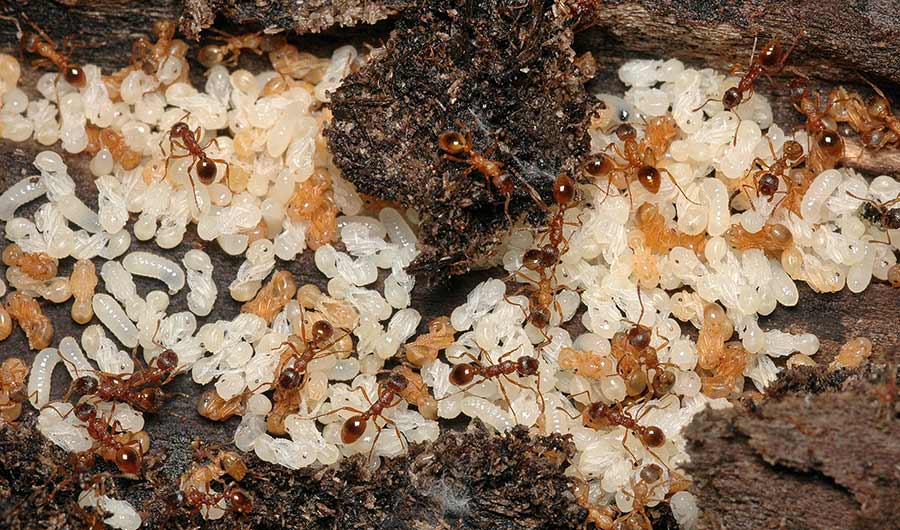Fire Ants Know That in Unity There is Strength

D. Kucharski K. Kucharska/Shutterstock
(Inside Science) -- When an invasive species -- plant or animal -- invades an area, there usually is competition for space and food with the residents, but after a while, the species can sometimes settle into an arrangement where every inhabitant lives in relative harmony.
But nature isn’t peaceful all the time. If the European version of fire ants, Myrmica rubra, moves into a new neighborhood -- as they have in a wetlands near Buffalo, New York, they tend to go right after the local ants’ queen, which essentially decimates the original colony.
A group of scientists from the SUNY Buffalo State found the species’ unique strategy for beating out other ant species. They published their findings in the journal Biological Invasions.
Ants are one of the creatures biologists tend to love. They have a highly organized society and, like Star Trek’s Borg, can meld into one deadly superorganism to conquer territory. Entomologist E.O. Wilson created a whole theory of biology, sociobiology and evolution studying ants.
The scientists claim that the European fire ants succeed because while other species of ants are busy competing among themselves for food and space, the European fire ants focus on conquering other species with laser concentration, so they can win out even if they themselves are vastly outnumbered in the beginning. Once they have eliminated their competition, the fire ant population can then explode in the summer when food is abundant and the population crashes in the autumn.
Despite the fact they are largely inept warriors and not very good at collecting food either, the European fire ants are united in taking food and conquering space, said Robert Warren, associate professor of biology at SUNY Buffalo State. The results are clear: A fire ant invasion leaves almost no other species of ants left. Ninety-five percent are wiped out, Warren said.
Fire ants get their name from the sting they can administer to kill small animals for food and to defend their colony. They swarm in unbelievable flowing carpets of ants, Warren said, eating anything in their way. The ants he studies originated in Europe, and were probably carried to North America in ship ballast. The Tifft Nature Preserve, where Warren conducted the study, is a restored wetland that was once an industrial dump five minutes from downtown Buffalo and is now one of many North American areas infested by these ants, including the Canadian Maritime provinces.
When ants invade, Warren said, biologists would assume that the winners of territorial wars were either good scavengers or fighters, or they were just filling a biological niche, perhaps one that opened up due to human activities.
However, in the case of the European fire ants, Warren found that neither is true. Studying the ants in the nature preserve, mostly around wet logs, and in elaborate ant houses of chambers and tubes in his lab, he found that there is no niche. After watching ant wars in his lab, Warren and his team concluded the M. rubra were not every good soldiers.
“Looking at food retrieval, the natives were dramatically better at retrieving food,” he said.
So, while the native colonies are fighting among themselves for food and territory, M. rubra are united to the point where it seems they are all one colony -- perhaps covering the entire western New York state -- instead of having competing colonies like other ant species.
All the ants in a colony have the same mother, the queen. They will tolerate each other, but not ants from a different mother, said Joshua King, an ant researcher at the University of Central Florida who was not involved in the study. The former can wander around in the colony territory unscathed, but the latter will be attacked immediately.
If an Alaskan wolf was dropped in the territory of a Siberian wolf it would be torn apart within minutes, Warren said. Fire ants have the same attitude.
But if another colony of the same species also moves in, they make room and live in harmony, he said.
Warren, an ecologist, got into ant study because they were excellent “guinea pigs” for watching nature work.
Even though studying ants and their habitats generally doesn’t take up too much laboratory space and is relatively easy and cheap to maintain, it does come with some risk. Wilson has been stung by so many ants he has lost feeling in his fingers. King has developed an allergic reaction to the venom in the stings.
“They changed my behavior,” said Warren, who is more careful than he used to be to avoid stings.
Editor's Note (January 16, 2019): We corrected the name of the researchers' institution after publishing. We regret the error.

